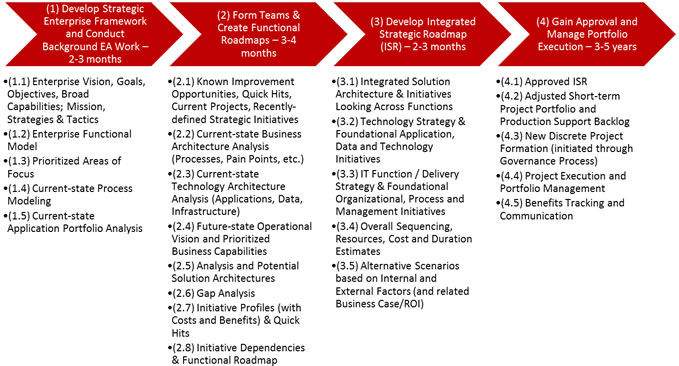http://stevegeorghakis.blogspot.com.es/p/business-driven-it-strategy.html

Overview
Companies with well-conceived business and IT strategies and plans (BDITS) operate more effectively than those without. It is necessary for these strategies and plans to span a 3-5 year horizon in most cases due to the magnitude of work required to fully implement necessary solutions. The benefits of creating and sustaining a well defined BDITS include:
- Effective alignment among key senior executives regarding business strategy – resulting in coordinated decision-making and synchronized efforts across many functions.
- Improved organization morale and motivation through common understanding of the connection of their daily work to an end state that’s beneficial to the entire company.
- A massive reduction in wasted time and money on projects and other spending within the business and IT which is not aligned with the important capabilities needed by the company.
- Dramatically increased “speed to market” with regard to new solutions for external customers and faster internal project execution by the business and IT.
- Ability to “stay the course” while still being able to support periodic plan deviations through a more effective perspective on how these deviations fit within the context of major necessary improvements over the long haul.
- All of the above can yield to improved ability to innovate and execute in critical “business capability” areas allowing the organization to improve efficiency and operating effectiveness … driving better top-line and bottom-line financial results and improved shareholder returns.
BDITS Activities and Deliverables
Activities that need to be performed during an initial BDITS will require substantial time and effort on the part of the organization, and usually will require assistance from a third-party consulting firm with experience performing work of this nature for companies in similar industries. It is both the assistance from a time and effort standpoint, and the expertise that drives the need for external assistance. The activities described below can be performed anywhere from 7-10 months by most organizations (and accomplished in a more compressed time for some companies depending on the scope pursued).
(1) Develop Strategic Enterprise Framework and Conduct Background EA Work
This set of activities involves defining the strategic aspects of the future-state that the company intends to put in place, and performing the background work on the current-state business operation to prepare for the next stage of work. Effective current-state work products will help to focus subsequent BDITS activities and reduce the time and cost of external consulting assistance to help analyze and document the current-state.
(2) Form Teams and Create Functional Roadmaps
This set of activities involves applying the strategic inputs defined in Phase 1 – above, and applying them broadly to the enterprise across functions AND in an in-depth manner in priority functional areas of focus. For all functional areas, high-level pain points and improvement opportunities are gathered from existing data and information (e.g. desired projects, open IT enhancement requests, recently conducted analyses, etc.) and several work sessions are conducted with business and IT leaders in these areas. For priority areas of focus, more detailed work is performed involving an extensive analysis of the current-state business and technology operation, definition of functional business objectives, creation of a vision of how the company wants to operate in this functional area in the future (using strategic inputs defined in Phase 1), definition of detailed business capabilities which must be put in place to meet functional objectives, a gap analysis of where the company stands today versus the future desired vision, and a plan (which will address people, process and technology) for achieving the desired future vision over the next 3-5 years. Functional roadmaps defined in Phase 2 are a key input to the Integrated Strategic Roadmap (IRS) developed in Phase 3.
(3) Develop Integrated Strategic Roadmap
The integrated strategic roadmap is Phase 3 of the BDITS initiative and involves synthesizing the functional roadmaps created in Phase 2 and creating an overall solution architecture for implementing appropriate initiatives defined in the functional roadmaps. It is important to note that it is highly likely that not all of the initiatives defined by the functional teams during Phase 2 will “make the cut” in the Integrated Strategic Roadmap (for reasons which involve potential overlap and redundancies with initiatives created by other functional teams, overall capacity of the organization to implement solutions and other sequencing issues related to the nature of the underlying foundational technology which must be put in place to support all of the functions in aggregate).
(4) Gain Approval and Manage Portfolio Execution
This final major phase refers to the approval gained from the Board and Executive Committee to move forward with the implementation of initiatives defined in the BDITS, and then the subsequent adjustments to the existing portfolio and formation and launch of specific BDITS projects.
With the above being said, in order to effectively execute on a BDITS, a well-implementedframework is absolutely necessary.
No hay comentarios:
Publicar un comentario